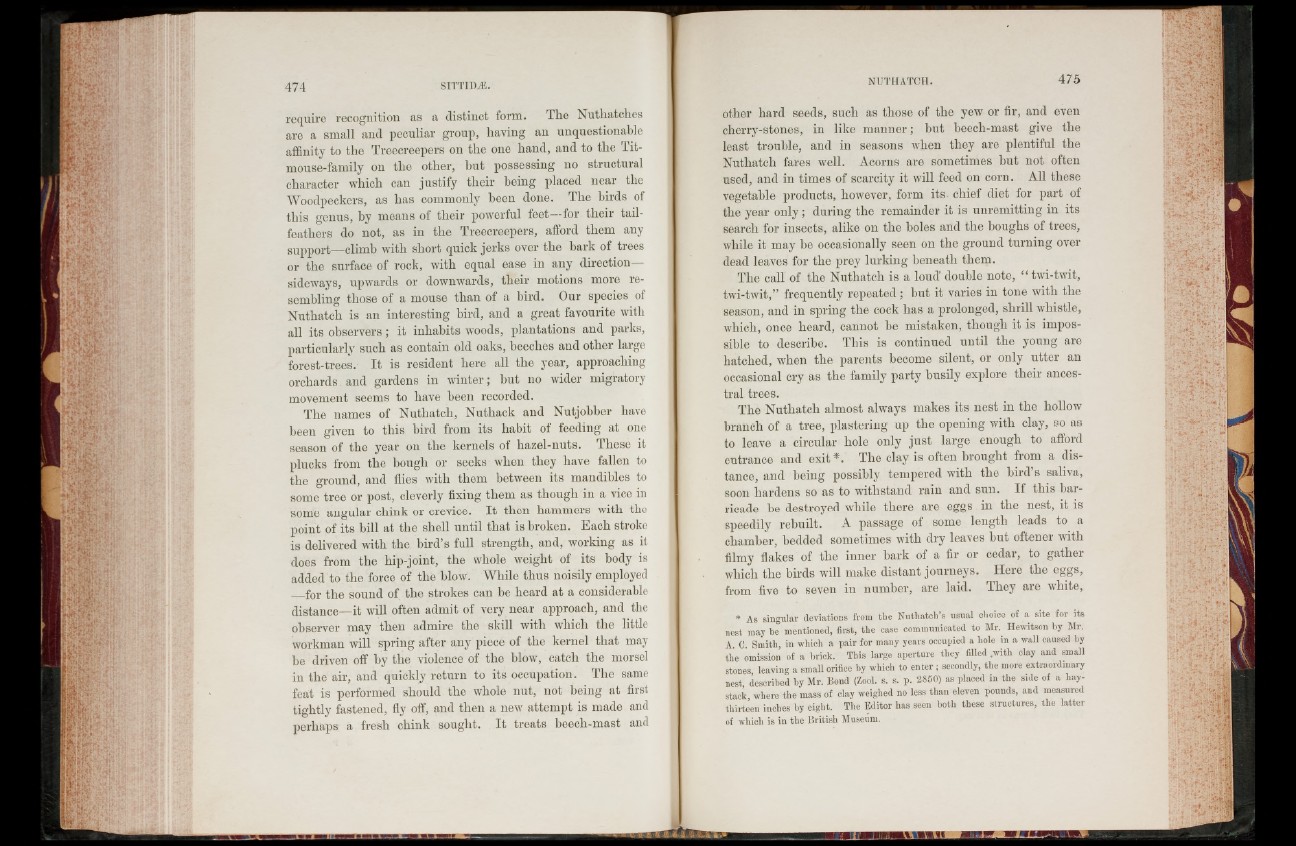
require recognition as a distinct form. The Nuthatches
are a small and peculiar group, having an unquestionable
affinity to the Treecreepers on the one hand, and to the Titmouse
family on the other, hut possessing no structural
character which can justify their being placed near the
Woodpeckers, as has commonly been done. The birds ol
this genus, by means of their powerful feet—for their tail-
feathers do not, as in the Treecreepers, afford them any
support—climb with short quick jerks over the hark of trees
or the surface of rock, with equal ease in any direction
sideways, upwards or downwards, their motions more resembling
those of a mouse than of a bird. Our species of
Nuthatch is an interesting bird, and a great favourite with
all its observers; it inhabits woods, plantations and parks,
particularly such as contain old oaks, beeches and other largo
forest-trees. I t is resident here all the year, approaching
orchards and gardens in winter; hut 110 wider migratory
movement seems to have been recorded.
The names of Nuthatch, Nuthack and Nutjobber have
been given to this bird from its habit of feeding at one
season of the year 0x1 the kei'nels of liazel-uuts. These it
plucks from the bough or seeks when they have fallen to
the ground, and flies with them between its mandibles to
some tree or post, cleverly fixing them as though in a vice in
some angular chink or crevice. It then hammers with the
point of its bill at the shell until that is broken. Each stroke
is delivered with the bird’s full strength, and, working as it
does from the hip-joint, the whole weight of its body is
added to the force of the blow. While thus noisily employed
for the sound of the strokes can be heard at a considerable
distance—it will often admit of very near approach, and the
observer may then admire the skill with which the little
workman will spring after any piece of the kernel that may
be driven off by the violence of the blow, catch the morsel
in the air, and quickly return to its occupation. The same
feat is performed should the whole nut, not being at first
tightly fastened, fly off, and then a new attempt is made and
perhaps a fresh chink sought. It treats beech-mast and
other hard seeds, such as those of the yew or fir, and even
cherry-stones, in like manner; but beech-mast give the
least trouble, and in seasons when they are plentiful the
Nuthatch fares well. Acorns are sometimes but not often
used, and in times of scarcity it will feed on corn. All these
vegetable products, however, form its chief diet for part of
the year only; during the remainder it is unremitting in its
search for insects, alike on the boles and the boughs of trees,
while it may be occasionally seen on the ground turning over
dead leaves for the prey lurking beneath them.
The call of the Nuthatch is a loud’ double note, “ twi-twit,
twi-twit,” frequently repeated; but it varies in tone with the
season, and in spring the cock has a prolonged, shrill whistle,
which, once heard, cannot be mistaken, though it is impossible
to describe. This is continued until the young are
hatched, when the parents become silent, or only utter an
occasional cry as the family party busily explore their ancestral
trees.
The Nuthatch almost always makes its nest in the hollow
branch of a tree, plastering up the opening with clay, so as
to leave a circular hole only just large enough to afford
entrance and exit *. The clay is often brought from a distance,
and being possibly tempered with the bird’s saliva,
soon hardens so as to withstand rain and sun. If this bai-
ricade be destroyed while there are eggs in the nest, it is
speedily rebuilt. A passage of some length leads to a
chamber, bedded sometimes with dry leaves but oftener with
filmy flakes of the inner bark of a fir or cedar, to gather
which the birds will make distant journeys. Here the eggs,
from five to seven in number, are laid. They are white,
* As singular deviations from the Nuthatch’s usual choice of a site for its
nest may be mentioned, first, the case communicated to Mr. Hewitson by Mr.
A. 0. Smith, in which a pair for many years occupied a hole in a wall caused by
the omission of a brick. This large aperture they filled .with clay and small
stones leaving a small orifice by which to enter ; secondly, the more extraordinary
nest described by Mr. Bond (Zool. s. s. p. 2850) as placed in the s.de of a haystack
where the mass of clay weighed no less than eleven pounds, and measured
thirteen inches by eight. The Editor has seen both these structures, the latter
of which is in the British Museum.